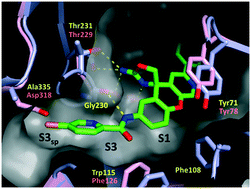Development of 2-aminooxazoline 3-azaxanthene β-amyloid cleaving enzyme (BACE) inhibitors with improved selectivity against Cathepsin D†‡
Abstract
As part of an ongoing effort at Amgen to develop a disease-modifying therapy for Alzheimer's disease, we have previously used the aminooxazoline xanthene (AOX) scaffold to generate potent and orally efficacious BACE1 inhibitors. While AOX-BACE1 inhibitors demonstrated acceptable cardiovascular safety margins, a retinal pathological finding in rat toxicological studies demanded further investigation. It has been widely postulated that such retinal toxicity might be related to off-target inhibition of Cathepsin D (CatD), a closely related aspartyl protease. We report the development of AOX-BACE1 inhibitors with improved selectivity against CatD by following a structure- and property-based approach. Our efforts culminated in the discovery of a picolinamide-substituted 3-aza-AOX-BACE1 inhibitor absent of retinal effects in an early screening rat toxicology study.



 Please wait while we load your content...
Please wait while we load your content...